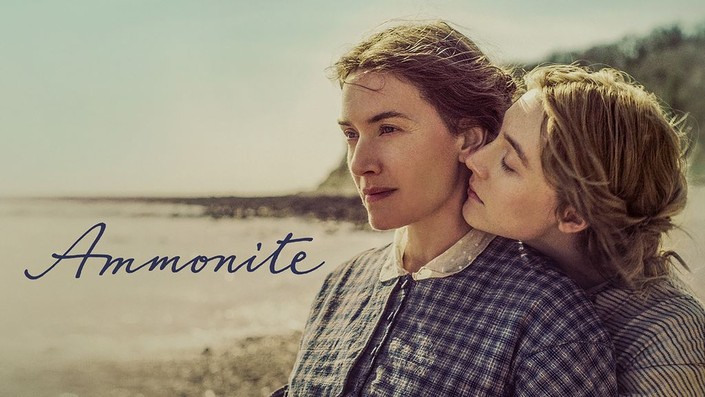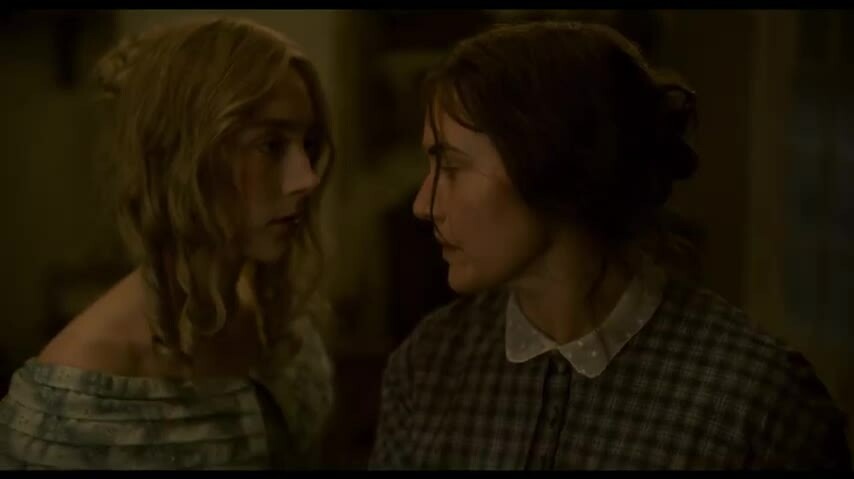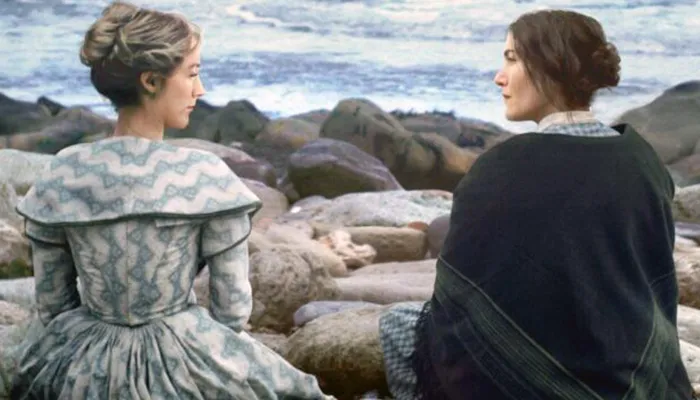Amonite (2020)
- nguyentruong
- November 27, 2024

Amonite (2020), directed by Francis Lee, is a quietly intense period drama set in 19th-century England that explores themes of love, isolation, and desire. The film is loosely inspired by the life of the famous paleontologist Mary Anning (Kate Winslet), though the romantic relationship at the center of the story is fictionalized. Amonite focuses on the intimate, passionate relationship between Mary, a reclusive fossil hunter, and Charlotte Murchison (Saoirse Ronan), a young woman who is sent to the seaside town of Lyme Regis for health reasons. Their bond evolves slowly, set against the stark beauty of the English coastline, and is marked by personal discovery, longing, and social constraint.
Mary Anning, a pioneering but overlooked paleontologist, is depicted as a solitary figure, dedicated to her work of collecting fossils along the cliffs of Lyme Regis. Her quiet, introverted life is defined by a deep passion for science, yet her accomplishments have gone largely unrecognized, primarily because of her gender and social status. Kate Winslet delivers a powerful, understated performance, portraying Mary as a woman of profound resilience and strength, yet one whose emotional life is stunted by both societal expectations and personal isolation.
Charlotte Murchison, played by Saoirse Ronan, enters Mary’s life when she is sent to Lyme Regis by her husband for a restorative stay. Charlotte is mourning the loss of a child, and her delicate health and fragile emotional state set the stage for a deep emotional connection between her and Mary. Initially, their relationship begins as one of mutual curiosity and a budding friendship. However, as the two women spend more time together, the bond between them grows into something more intimate and passionate. The romance between Mary and Charlotte is slow to unfold, but the chemistry between Winslet and Ronan is palpable, their characters drawn together by both their emotional vulnerability and mutual longing.
The film is centered on the tension between the societal repression of the time and the personal freedoms the women seek in their love for each other. As their relationship becomes more intense, it faces the unyielding social norms and judgment of the era, particularly the limited options for women who step outside conventional boundaries. Despite the tender moments they share, the relationship remains fraught with internal and external conflicts, as both women grapple with the consequences of their feelings.
 The cinematography by Stéphane Fontaine is beautifully evocative, capturing the sweeping, windswept cliffs and beaches of Lyme Regis. The desolate, often harsh landscape serves as a reflection of the characters’ inner turmoil and isolation. The coastal setting is as much a character as the women themselves, adding layers of emotional and thematic depth to the story. The muted, natural color palette further enhances the feeling of emotional restraint and the characters’ quiet lives.
The cinematography by Stéphane Fontaine is beautifully evocative, capturing the sweeping, windswept cliffs and beaches of Lyme Regis. The desolate, often harsh landscape serves as a reflection of the characters’ inner turmoil and isolation. The coastal setting is as much a character as the women themselves, adding layers of emotional and thematic depth to the story. The muted, natural color palette further enhances the feeling of emotional restraint and the characters’ quiet lives.
The film’s pacing is deliberate, allowing for a slow-building emotional intensity that makes the final moments all the more poignant. Amonite explores themes of personal sacrifice, the complexity of human connection, and the yearning for love in a world that demands conformity. At its heart, it’s a story about two women discovering parts of themselves through their connection to each other, both a source of solace and pain.
While Amonite is an exploration of forbidden love, it also delves deeply into the idea of personal reinvention and finding meaning in one’s life. The performances, particularly by Winslet and Ronan, are subtle yet deeply emotional, capturing the nuances of love, loss, and longing. The film is both intimate and haunting, leaving a lasting impression long after the credits roll.
 In conclusion, Amonite is a beautifully crafted, emotionally resonant film that explores the complexities of love, identity, and desire, set against a beautifully desolate 19th-century English backdrop. Winslet and Ronan’s performances elevate the film, making it a poignant meditation on what it means to love and be loved in a world that often doesn’t allow for it. The film’s quiet strength and emotional depth make it a standout piece in the genre of historical romance.
In conclusion, Amonite is a beautifully crafted, emotionally resonant film that explores the complexities of love, identity, and desire, set against a beautifully desolate 19th-century English backdrop. Winslet and Ronan’s performances elevate the film, making it a poignant meditation on what it means to love and be loved in a world that often doesn’t allow for it. The film’s quiet strength and emotional depth make it a standout piece in the genre of historical romance.










